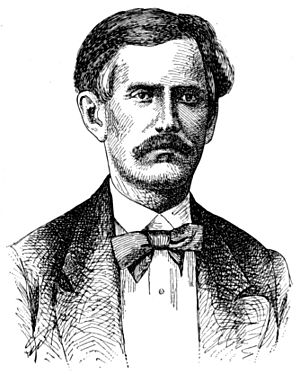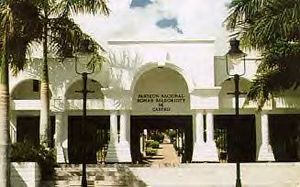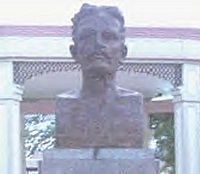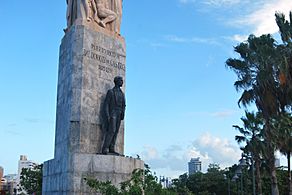Román Baldorioty de Castro facts for kids
Quick facts for kids
Román Baldorioty de Castro
|
|
|---|---|
 |
|
| Born | 23 February 1822 |
| Died | 30 September 1889 (aged 67) |
| Occupation | Professor, political activist |
Román Baldorioty de Castro (born February 23, 1822 – died September 30, 1889) was an important leader from Puerto Rico. He worked to end slavery and believed that Puerto Rico should be able to govern itself. In 1870, he became a representative in the Cortes Generales, which was Spain's parliament. There, he pushed for the end of slavery. In 1887, Baldorioty de Castro started the Partido Autonomista (Autonomist Party), a political group that wanted more self-rule for Puerto Rico.
Contents
Early Life and Education
Román Baldorioty de Castro was born in Guaynabo into a family that didn't have much money. When he was young, his family moved to San Juan. There, he went to school and was taught by a famous teacher named Rafael Cordero. After his first years of school, he went to El Seminario Conciliar de Idelfonso, which was a top school in Puerto Rico at the time. He spent most of his teenage years studying hard and was one of the best students in his class.
Studying in Spain and France
Baldorioty de Castro earned a special award called a scholarship, which helped him pay for more studies in Spain. He gathered enough money to travel and went to Spain with three other Puerto Ricans. Before settling in Madrid, they visited many places in Spain, like Cordoba and Seville. They even met a famous Spanish educator named Alberto Lista.
While studying at the Central University of Madrid, two of his friends got sick with smallpox and sadly passed away. Baldorioty de Castro was offered a chance to go back home, but he chose to stay and continue his studies. He graduated with degrees in physics and math. With his friend Dr. José Gualberto Padilla, he helped start a group in Puerto Rico called "La Sociedad Económica de Amigos del País en Puerto Rico" (the Economic Friends of Puerto Rico). This group worked to improve the island. In 1851, he got permission to go to France to study more. He moved to Paris and attended the Central School of Arts.
Working for Puerto Rico
In 1853, after seven years of studying abroad, Baldorioty de Castro returned to Puerto Rico. He married Isabel Matilde Díaz y Ruiz. When he came back, he saw that there were problems between the governor and the people who wanted to improve education and politics in Puerto Rico.
Baldorioty de Castro started working to make changes in society, politics, and education. Because of his efforts, the governor offered him a job as mayor of a town. But Baldorioty de Castro said no because he had different ideas. At that time, the government didn't really want to help the local people (called Criollos) get a better education. He became a member of the Liberal Reform Party of Puerto Rico in 1853.
A Dedicated Educator
Besides politics, Baldorioty de Castro loved teaching. He taught subjects like Botany and Maritime Sciences at a school in San Juan. In 1854, he became a botany professor at the Councilor Seminary. Later that year, he also taught Maritime Studies at a Nautical School.
In 1856, the government found fertile land on the islands of Mona and Monito. They chose Baldorioty de Castro to lead experiments to find out what the land was made of.
In 1857, Puerto Rico's cattle industry faced problems. Baldorioty de Castro was part of a group that worked to solve this issue. He also suggested that geometry classes should be taught in elementary schools, and his idea was accepted. In 1860, he became a spokesperson for a group that wanted to protect the island's natural resources. Later that year, he became a representative for Puerto Rico in the Spanish Parliament, serving for five years until 1865.
Fighting for Rights in Spain
While in the Spanish Parliament, Baldorioty de Castro used his position to speak out. He strongly pushed for the end of slavery in Puerto Rico and Cuba. He also worked on creating a constitution to give Puerto Ricans more political rights. In 1866, he was chosen to represent Puerto Rico at a big event in Paris called the Universal Exposition of 1867. He wrote a report about what he saw there.
When he returned to Puerto Rico, tensions were high. Many people wanted slavery to end, but the Spanish government resisted. This led to protests and even a rebellion known as the Grito de Lares. Baldorioty de Castro didn't support fighting. Instead, he preferred to solve problems through talks and diplomacy. After the rebellion attempts, a new government was set up. Baldorioty de Castro tried to bring different groups together to make reforms, but it was hard to get everyone to agree. He then traveled to Madrid to explain Puerto Rico's situation to the Spanish authorities.
He wrote many papers criticizing the colonial government. He also made a report listing the ways the government was harming the island's society and economy. In 1870, he was again named a representative to the Spanish Parliament. There, he continued to fight for his cause. Baldorioty de Castro became known as "The Father of Puerto Rican Autonomy" because he worked so hard for the island to have more self-rule. On November 19, 1872, Román Baldorioty de Castro, along with others, presented a plan to end slavery. On March 22, 1873, the Spanish Government approved this plan, which became known as the Moret Law.
Later Years and Legacy

Baldorioty de Castro returned to Puerto Rico in 1873 and moved to the city of Ponce. There, he started a newspaper called El Derecho (The Law). He also founded a weekly paper called La Crónica, where he shared his ideas about Puerto Rico governing itself.
In 1887, Baldorioty de Castro, along with José de Diego, co-founded the Autonomist Party of Puerto Rico. This was one of Puerto Rico's first political parties. Its main goal was for Puerto Rico to choose its own government and have a representative in the Spanish Parliament.
The Spanish government saw Baldorioty de Castro as a threat. They arrested him and put him in Fort San Felipe del Morro in San Juan. Even though he was not in jail for long, his health suffered greatly from this experience. Román Baldorioty de Castro passed away in Ponce on September 30, 1889. He is buried in Ponce's old cemetery, which was renamed "Panteón Nacional Román Baldorioty de Castro" in his honor.
Honoring a Hero
Many places in Puerto Rico remember Baldorioty de Castro. Cities like Bayamón, Juana Díaz, San Germán, and San Juan have plazas named after him. Puerto Rico Highway 26, a major road to the airport, is called the Román Baldorioty de Castro Expressway. In San Juan, there's an obelisk (a tall, thin monument) in a park near the Condado Lagoon that honors him. A bronze statue of him stands at the base of this monument. Schools in Puerto Rico and even a high school in the Dominican Republic are named after him.
Gallery
See also
 In Spanish: Román Baldorioty de Castro para niños
In Spanish: Román Baldorioty de Castro para niños
- List of Puerto Ricans
- Politics of Puerto Rico
- Autonomism
- Panteon Nacional Roman Baldorioty de Castro





